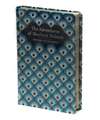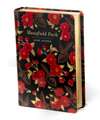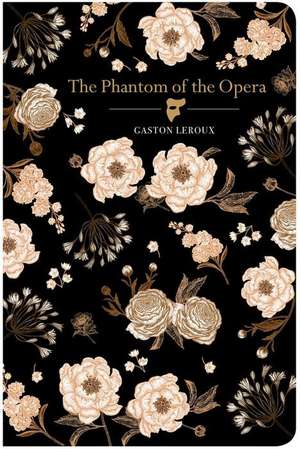The Phantom of the Opera: Chiltern Classic
Autor Gaston Lerouxen Limba Engleză Hardback – 2 ian 2024
Din seria Chiltern Classic
-
 Preț: 132.74 lei
Preț: 132.74 lei -
 Preț: 124.95 lei
Preț: 124.95 lei -
 Preț: 126.75 lei
Preț: 126.75 lei -
 Preț: 124.58 lei
Preț: 124.58 lei -
 Preț: 126.75 lei
Preț: 126.75 lei -
 Preț: 128.04 lei
Preț: 128.04 lei -
 Preț: 131.61 lei
Preț: 131.61 lei -
 Preț: 127.26 lei
Preț: 127.26 lei -
 Preț: 125.46 lei
Preț: 125.46 lei -
 Preț: 131.61 lei
Preț: 131.61 lei -
 Preț: 132.90 lei
Preț: 132.90 lei -
 Preț: 127.76 lei
Preț: 127.76 lei -
 Preț: 127.51 lei
Preț: 127.51 lei -
 Preț: 125.97 lei
Preț: 125.97 lei -
 Preț: 129.31 lei
Preț: 129.31 lei -
 Preț: 128.27 lei
Preț: 128.27 lei -
 Preț: 126.75 lei
Preț: 126.75 lei -
 Preț: 127.51 lei
Preț: 127.51 lei -
 Preț: 130.84 lei
Preț: 130.84 lei -
 Preț: 124.79 lei
Preț: 124.79 lei -
 Preț: 125.18 lei
Preț: 125.18 lei -
 Preț: 127.26 lei
Preț: 127.26 lei -
 Preț: 126.24 lei
Preț: 126.24 lei -
 Preț: 132.13 lei
Preț: 132.13 lei -
 Preț: 125.72 lei
Preț: 125.72 lei -
 Preț: 124.70 lei
Preț: 124.70 lei -
 Preț: 127.51 lei
Preț: 127.51 lei -
 Preț: 129.24 lei
Preț: 129.24 lei -
 Preț: 126.75 lei
Preț: 126.75 lei -
 Preț: 131.10 lei
Preț: 131.10 lei -
 Preț: 125.46 lei
Preț: 125.46 lei -
 Preț: 133.40 lei
Preț: 133.40 lei -
 Preț: 125.20 lei
Preț: 125.20 lei -
 Preț: 126.75 lei
Preț: 126.75 lei -
 Preț: 126.75 lei
Preț: 126.75 lei -
 Preț: 130.84 lei
Preț: 130.84 lei -
 Preț: 131.61 lei
Preț: 131.61 lei -
 Preț: 124.95 lei
Preț: 124.95 lei -
 Preț: 128.27 lei
Preț: 128.27 lei -
 Preț: 125.72 lei
Preț: 125.72 lei -
 Preț: 128.71 lei
Preț: 128.71 lei -
 Preț: 125.97 lei
Preț: 125.97 lei -
 Preț: 124.95 lei
Preț: 124.95 lei -
 Preț: 128.68 lei
Preț: 128.68 lei -
 Preț: 130.59 lei
Preț: 130.59 lei -
 Preț: 129.31 lei
Preț: 129.31 lei -
 Preț: 128.79 lei
Preț: 128.79 lei -
 Preț: 124.95 lei
Preț: 124.95 lei -
 Preț: 125.72 lei
Preț: 125.72 lei -
 Preț: 130.03 lei
Preț: 130.03 lei
Preț: 127.51 lei
Nou
Puncte Express: 191
Preț estimativ în valută:
24.40€ • 25.54$ • 20.19£
24.40€ • 25.54$ • 20.19£
Carte disponibilă
Livrare economică 15-29 martie
Livrare express 01-07 martie pentru 29.58 lei
Preluare comenzi: 021 569.72.76
Specificații
ISBN-13: 9781914602221
ISBN-10: 1914602226
Pagini: 244
Dimensiuni: 122 x 188 x 25 mm
Greutate: 0.48 kg
Editura: chiltern publishing
Seria Chiltern Classic
ISBN-10: 1914602226
Pagini: 244
Dimensiuni: 122 x 188 x 25 mm
Greutate: 0.48 kg
Editura: chiltern publishing
Seria Chiltern Classic
Notă biografică
Gaston Leroux was a french novelist, best known for his works (The Phantom of the Opera), which later became famous in various film and stage renditions. After leaving school, Leroux worked as a clerk in a law office and began writing essays and short stories. In the early 1900s he began writing novels, his first success being (The Mystery of the Yellow Room), starring the amateur detective Joseph Rouletabille. A number of sequels followed, none quite so successful. In 1910 "The Phantom of the Opera" received only moderate sales and somewhat poor reviews, although Andrew Lloyd Webber's musical The Phantom of the Opera (1986) brought Leroux's novel renewed fame.
Extras
Chapter One
Is It the Ghost? It was the evening on which MM. Debienne and Poligny, the managers of the Opera, were giving a last gala performance to mark their retirement. Suddenly the dressing-room of La Sorelli, one of the principal dancers, was invaded by half-a-dozen young ladies of the ballet, who had come up from the stage after “dancing” Polyeucte. They rushed in amid great confusion, some giving vent to forced and unnatural laughter, others to cries of terror. Sorelli, who wished to be alone for a moment to “run through” the speech which she was to make to the resigning managers, looked around angrily at the mad and tumultuous crowd. It was little Jammes—the girl with the tip-tilted nose, the forget-me-not eyes, the rose-red cheeks and the lily-white neck and shoulders—who gave the explanation in a trembling voice:
“It’s the ghost!” And she locked the door.
Sorelli’s dressing-room was fitted up with official, commonplace elegance. A pier-glass, a sofa, a dressing-table and a cupboard or two provided the necessary furniture. On the walls hung a few engravings, relics of the mother, who had known the glories of the old Opera in the Rue le Peletier; portraits of Vestris, Gardel, Dupont, Bigottini. But the room seemed a palace to the brats of the corps de ballet, who were lodged in common dressing-rooms where they spent their time singing, quarreling, smacking the dressers and hair-dressers and buying one another glasses of cassis, beer, or even rhum, until the callboy’s bell rang.
Sorelli was very suspicious. She shuddered when she heard little Jammes speak of the ghost, called her a “silly little fool” and then, as she was the first to believe in ghosts in general, and the Opera ghost in particular, at once asked for details:
“Have you seen him?”
“As plainly as I see you now!” said little Jammes, whose legs were giving way beneath her, and she dropped with a moan into a chair.
Thereupon little Giry—the girl with eyes black as sloes, hair black as ink, a swarthy complexion and a poor little skin stretched over poor little bones—little Giry added:
“If that’s the ghost, he’s very ugly!”
“Oh, yes!” cried the chorus of ballet-girls.
And they all began to talk together. The ghost had appeared to them in the shape of a gentleman in dress-clothes, who had suddenly stood before them in the passage, without their knowing where he came from. He seemed to have come straight through the wall.
“Pooh!” said one of them, who had more or less kept her head. “You see the ghost everywhere!”
And it was true. For several months, there had been nothing discussed at the Opera but this ghost in dress-clothes who stalked about the building, from top to bottom, like a shadow, who spoke to nobody, to whom nobody dared speak and who vanished as soon as he was seen, no one knowing how or where. As became a real ghost, he made no noise in walking. People began by laughing and making fun of this specter dressed like a man of fashion or an undertaker; but the ghost legend soon swelled to enormous proportions among the corps de ballet. All the girls pretended to have met this supernatural being more or less often. And those who laughed the loudest were not the most at ease. When he did not show himself, he betrayed his presence or his passing by accident, comic or serious, for which the general superstition held him responsible. Had any one met with a fall, or suffered a practical joke at the hands of one of the other girls, or lost a powderpuff, it was at once the fault of the ghost, of the Opera ghost.
After all, who had seen him? You meet so many men in dress-clothes at the Opera who are not ghosts. But this dress-suit had a peculiarity of its own. It covered a skeleton. At least, so the ballet-girls said. And, of course, it had a death’s head.
Was all this serious? The truth is that the idea of the skeleton came from the description of the ghost given by Joseph Buquet, the chief scene-shifter, who had really seen the ghost. He had run up against the ghost on the little staircase, by the footlights, which leads to “the cellars.” He had seen him for a second—for the ghost had fled—and to any one who cared to listen to him he said:
“He is extraordinarily thin and his dress-coat hangs on a skeleton frame. His eyes are so deep that you can hardly see the fixed pupils. You just see two big black holes, as in a dead man’s skull. His skin, which is stretched across his bones like a drumhead, is not white, but a nasty yellow. His nose is so little worth talking about that you can’t see it side-face; and the absence of that nose is a horrible thing to look at. All the hair he has is three or four long dark locks on his forehead and behind his ears.”
This chief scene-shifter was a serious, sober, steady man, very slow at imagining things. His words were received with interest and amazement; and soon there were other people to say that they too had met a man in dress-clothes with a death’s head on his shoulders. Sensible men who had wind of the story began by saying that Joseph Buquet had been the victim of a joke played by one of his assistants. And then, one after the other, there came a series of incidents so curious and so inexplicable that the very shrewdest people began to feel uneasy.
For instance, a fireman is a brave fellow! He fears nothing, least of all fire! Well, the fireman in question, who had gone to make a round of inspection in the cellars and who, it seems, had ventured a little farther than usual, suddenly reappeared on the stage, pale, scared, trembling, with his eyes starting out of his head, and practically fainted in the arms of the proud mother of little Jammes.* And why? Because he had seen coming toward him, at the level of his head, but without a body attached to it, a head of fire! And, as I said, a fireman is not afraid of fire.
The fireman’s name was Pampin.
The corps de ballet was flung into consternation. At first sight, this fiery head in no way corresponded with Joseph Buquet’s description of the ghost. But the young ladies soon persuaded themselves that the ghost had several heads, which he changed about as he pleased. And, of course, they at once imagined that they were in the greatest danger. Once a fireman did not hesitate to faint, leaders and front-row and back-row girls alike had plenty of excuses for the fright that made them quicken their pace when passing some dark corner or ill-lighted corridor. Sorelli herself, on the day after the adventure of the fireman, placed a horse-shoe on the table in front of the stage-door-keeper’s box, which every one who entered the Opera otherwise than as a spectator must touch before setting foot on the first tread of the staircase. This horse-shoe was not invented by me—any more than any other part of this story, alas!—and may still be seen on the table in the passage outside the stage-door-keeper’s box, when you enter the Opera through the court known as the Cour de l’Administration.
To return to the evening in question.
“It’s the ghost!” little Jammes had cried.
An agonizing silence now reigned in the dressing-room. Nothing was heard but the hard breathing of the girls. At last, Jammes, flinging herself upon the farthest corner of the wall, with every mark of real terror on her face, whispered:
“Listen!”
*I have the anecdote, which is quite authentic, from M. Pedro Gailhard himself, the late manager of the Opera.
Everybody seemed to hear a rustling outside the door. There was no sound of footsteps. It was like light silk sliding over the panel. Then it stopped.
Sorelli tried to show more pluck than the others. She went up to the door and, in a quavering voice, asked:
“Who’s there?”
But nobody answered. Then feeling all eyes upon her, watching her last movement, she made an effort to show courage, and said very loudly:
“Is there any one behind the door?”
“Oh, yes, yes! Of course there is!” cried that little dried plum of a Meg Giry, heroically holding Sorelli back by her gauze skirt. “Whatever you do, don’t open the door! Oh, Lord, don’t open the door!”
But Sorelli, armed with a dagger that never left her, turned the key and drew back the door, while the ballet-girls retreated to the inner dressing-room and Meg Giry sighed:
“Mother! Mother!”
Sorelli looked into the passage bravely. It was empty; a gas-flame, in its glass prison, cast a red and suspicious light into the surrounding darkness, without succeeding in dispelling it. And the dancer slammed the door again, with a deep sigh.
“No,” she said, “there is no one there.”
“Still, we saw him!” Jammes declared, returning with timid little steps to her place beside Sorelli. “He must be somewhere prowling about. I shan’t go back to dress. We had better all go down to the foyer together, at once, for the ‘speech,’ and we will come up again together.”
Is It the Ghost? It was the evening on which MM. Debienne and Poligny, the managers of the Opera, were giving a last gala performance to mark their retirement. Suddenly the dressing-room of La Sorelli, one of the principal dancers, was invaded by half-a-dozen young ladies of the ballet, who had come up from the stage after “dancing” Polyeucte. They rushed in amid great confusion, some giving vent to forced and unnatural laughter, others to cries of terror. Sorelli, who wished to be alone for a moment to “run through” the speech which she was to make to the resigning managers, looked around angrily at the mad and tumultuous crowd. It was little Jammes—the girl with the tip-tilted nose, the forget-me-not eyes, the rose-red cheeks and the lily-white neck and shoulders—who gave the explanation in a trembling voice:
“It’s the ghost!” And she locked the door.
Sorelli’s dressing-room was fitted up with official, commonplace elegance. A pier-glass, a sofa, a dressing-table and a cupboard or two provided the necessary furniture. On the walls hung a few engravings, relics of the mother, who had known the glories of the old Opera in the Rue le Peletier; portraits of Vestris, Gardel, Dupont, Bigottini. But the room seemed a palace to the brats of the corps de ballet, who were lodged in common dressing-rooms where they spent their time singing, quarreling, smacking the dressers and hair-dressers and buying one another glasses of cassis, beer, or even rhum, until the callboy’s bell rang.
Sorelli was very suspicious. She shuddered when she heard little Jammes speak of the ghost, called her a “silly little fool” and then, as she was the first to believe in ghosts in general, and the Opera ghost in particular, at once asked for details:
“Have you seen him?”
“As plainly as I see you now!” said little Jammes, whose legs were giving way beneath her, and she dropped with a moan into a chair.
Thereupon little Giry—the girl with eyes black as sloes, hair black as ink, a swarthy complexion and a poor little skin stretched over poor little bones—little Giry added:
“If that’s the ghost, he’s very ugly!”
“Oh, yes!” cried the chorus of ballet-girls.
And they all began to talk together. The ghost had appeared to them in the shape of a gentleman in dress-clothes, who had suddenly stood before them in the passage, without their knowing where he came from. He seemed to have come straight through the wall.
“Pooh!” said one of them, who had more or less kept her head. “You see the ghost everywhere!”
And it was true. For several months, there had been nothing discussed at the Opera but this ghost in dress-clothes who stalked about the building, from top to bottom, like a shadow, who spoke to nobody, to whom nobody dared speak and who vanished as soon as he was seen, no one knowing how or where. As became a real ghost, he made no noise in walking. People began by laughing and making fun of this specter dressed like a man of fashion or an undertaker; but the ghost legend soon swelled to enormous proportions among the corps de ballet. All the girls pretended to have met this supernatural being more or less often. And those who laughed the loudest were not the most at ease. When he did not show himself, he betrayed his presence or his passing by accident, comic or serious, for which the general superstition held him responsible. Had any one met with a fall, or suffered a practical joke at the hands of one of the other girls, or lost a powderpuff, it was at once the fault of the ghost, of the Opera ghost.
After all, who had seen him? You meet so many men in dress-clothes at the Opera who are not ghosts. But this dress-suit had a peculiarity of its own. It covered a skeleton. At least, so the ballet-girls said. And, of course, it had a death’s head.
Was all this serious? The truth is that the idea of the skeleton came from the description of the ghost given by Joseph Buquet, the chief scene-shifter, who had really seen the ghost. He had run up against the ghost on the little staircase, by the footlights, which leads to “the cellars.” He had seen him for a second—for the ghost had fled—and to any one who cared to listen to him he said:
“He is extraordinarily thin and his dress-coat hangs on a skeleton frame. His eyes are so deep that you can hardly see the fixed pupils. You just see two big black holes, as in a dead man’s skull. His skin, which is stretched across his bones like a drumhead, is not white, but a nasty yellow. His nose is so little worth talking about that you can’t see it side-face; and the absence of that nose is a horrible thing to look at. All the hair he has is three or four long dark locks on his forehead and behind his ears.”
This chief scene-shifter was a serious, sober, steady man, very slow at imagining things. His words were received with interest and amazement; and soon there were other people to say that they too had met a man in dress-clothes with a death’s head on his shoulders. Sensible men who had wind of the story began by saying that Joseph Buquet had been the victim of a joke played by one of his assistants. And then, one after the other, there came a series of incidents so curious and so inexplicable that the very shrewdest people began to feel uneasy.
For instance, a fireman is a brave fellow! He fears nothing, least of all fire! Well, the fireman in question, who had gone to make a round of inspection in the cellars and who, it seems, had ventured a little farther than usual, suddenly reappeared on the stage, pale, scared, trembling, with his eyes starting out of his head, and practically fainted in the arms of the proud mother of little Jammes.* And why? Because he had seen coming toward him, at the level of his head, but without a body attached to it, a head of fire! And, as I said, a fireman is not afraid of fire.
The fireman’s name was Pampin.
The corps de ballet was flung into consternation. At first sight, this fiery head in no way corresponded with Joseph Buquet’s description of the ghost. But the young ladies soon persuaded themselves that the ghost had several heads, which he changed about as he pleased. And, of course, they at once imagined that they were in the greatest danger. Once a fireman did not hesitate to faint, leaders and front-row and back-row girls alike had plenty of excuses for the fright that made them quicken their pace when passing some dark corner or ill-lighted corridor. Sorelli herself, on the day after the adventure of the fireman, placed a horse-shoe on the table in front of the stage-door-keeper’s box, which every one who entered the Opera otherwise than as a spectator must touch before setting foot on the first tread of the staircase. This horse-shoe was not invented by me—any more than any other part of this story, alas!—and may still be seen on the table in the passage outside the stage-door-keeper’s box, when you enter the Opera through the court known as the Cour de l’Administration.
To return to the evening in question.
“It’s the ghost!” little Jammes had cried.
An agonizing silence now reigned in the dressing-room. Nothing was heard but the hard breathing of the girls. At last, Jammes, flinging herself upon the farthest corner of the wall, with every mark of real terror on her face, whispered:
“Listen!”
*I have the anecdote, which is quite authentic, from M. Pedro Gailhard himself, the late manager of the Opera.
Everybody seemed to hear a rustling outside the door. There was no sound of footsteps. It was like light silk sliding over the panel. Then it stopped.
Sorelli tried to show more pluck than the others. She went up to the door and, in a quavering voice, asked:
“Who’s there?”
But nobody answered. Then feeling all eyes upon her, watching her last movement, she made an effort to show courage, and said very loudly:
“Is there any one behind the door?”
“Oh, yes, yes! Of course there is!” cried that little dried plum of a Meg Giry, heroically holding Sorelli back by her gauze skirt. “Whatever you do, don’t open the door! Oh, Lord, don’t open the door!”
But Sorelli, armed with a dagger that never left her, turned the key and drew back the door, while the ballet-girls retreated to the inner dressing-room and Meg Giry sighed:
“Mother! Mother!”
Sorelli looked into the passage bravely. It was empty; a gas-flame, in its glass prison, cast a red and suspicious light into the surrounding darkness, without succeeding in dispelling it. And the dancer slammed the door again, with a deep sigh.
“No,” she said, “there is no one there.”
“Still, we saw him!” Jammes declared, returning with timid little steps to her place beside Sorelli. “He must be somewhere prowling about. I shan’t go back to dress. We had better all go down to the foyer together, at once, for the ‘speech,’ and we will come up again together.”
Recenzii
"The story of the monster man whose horrible deformities cause fear and terror, his search for love and acceptance, and his haunting of the opera house in Paris is told in very simple language. Beautifully adapted, the story flows along so easily that readers will be immediately caught up in the tangle of events and emotions. McMullan conveys all of the anger, grief, joy, and love that make the phantom a truly believable character. Will attract reluctant readers."--School Library Journal.
Textul de pe ultima copertă
The novel that inspired the Lon Chaney film and the hit musical. "The wildest and most fantastic of tales."--New York Times Book Review.






















